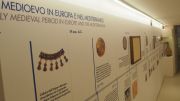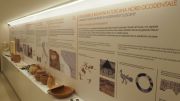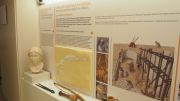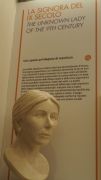Here there is the chronology of Early Middle Ages, where are highlighted the main events from 476 A.D. to the year one thousand. It refers particularly to the Mediterranean area and the birth of the Islamic civilization.
On the other side of the corridor, we can focus on what contemporary was happening in Northern Tuscany: there were the Lombards on the territory and at the same time the building of military castles on hills, then used as civic structures that tend to replace the cities, in the administration of the territory.
Thanks to the dedication of amanuenses monks and their careful and accurate transcription (whenever possible) we can read many ancient texts.
Here we can find a goose’ s feather, the lunellum (a crescent moon-shaped knife used to erase the letters) and the Roman reproduction of an illuminated manuscript.
In this phase, in our territory, increases the number of places of Christian worship in different shapes, as for example the pieve (a rural church with a baptistery, upon which other churches without baptisteries depended), the badia (an abbey) and the monastery (a building or complex of buildings comprising domestic quarters, workplaces of monks and the church).
In Camaiore, in Piazza Francigena was discovered a church of the end of the 9th century, that was on the side of the present church of Saint Michael, with a burial area all around that was used until the 14th century.
From the skull of one of this people, buried in the early medieval period, was obtained the face reproduction of a 40 years-old woman, probably of a high status as shown by the anthropological and nutritional analysis made on it.










